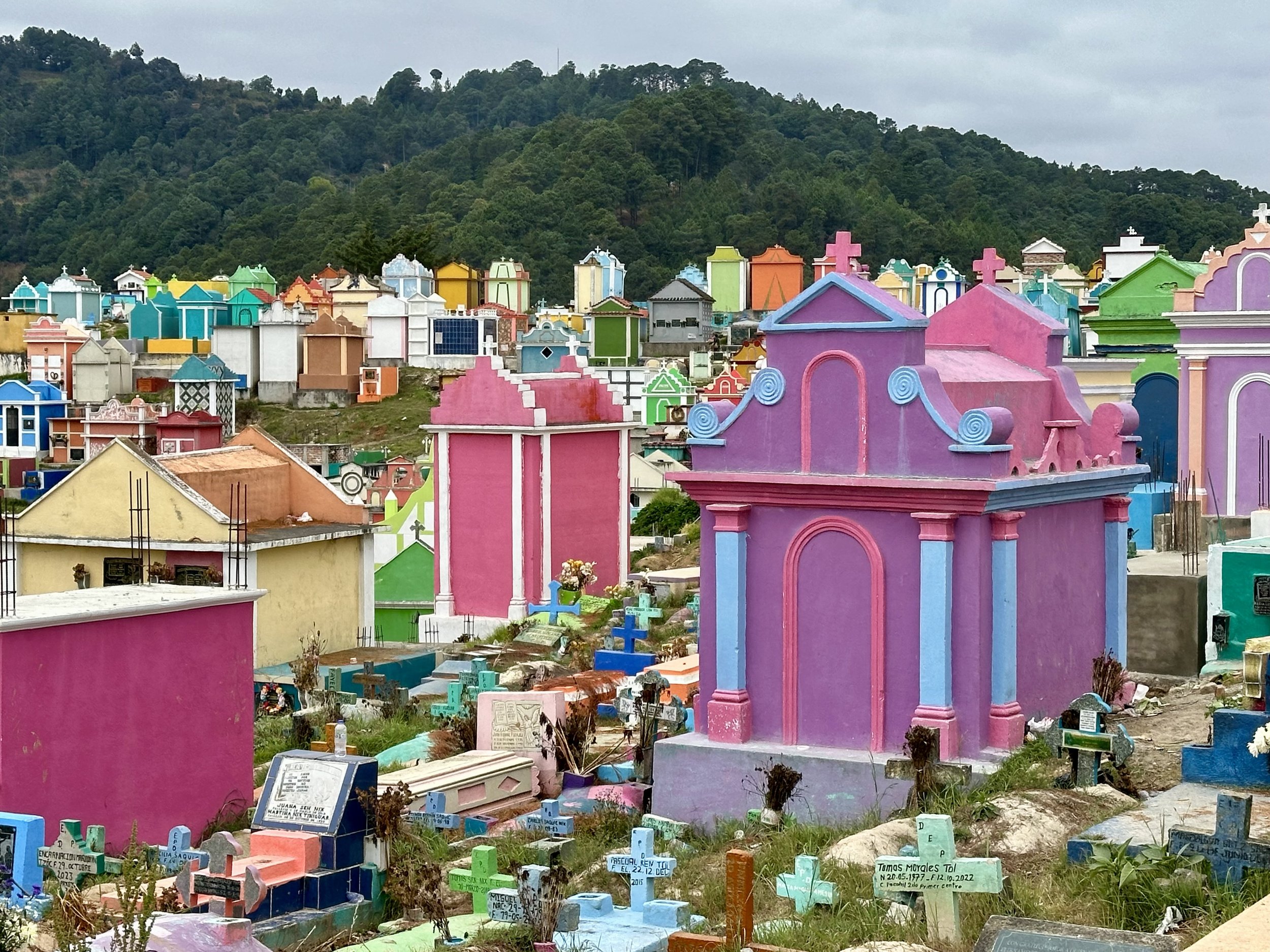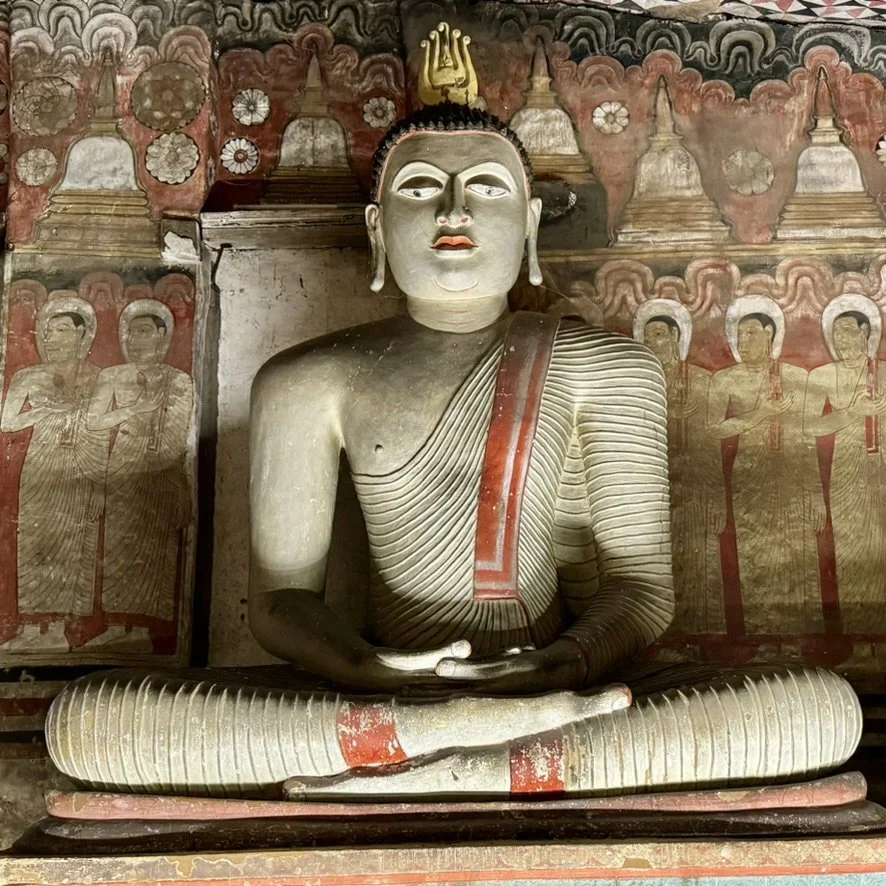Guatemala: “The Belt of Fire” 2024
We thoroughly enjoyed a 12-day adventure throughout Guatemala. We arrived in Guatemala City and immediately transferred to Antigua, since Guatemala City is basically a large industrial city. Guatemala City is also considered the “new town”, as the capital was moved there from Antigua in 1776 due to the devastating earthquakes that continued to destroy much of Antigua every 20 years or so.
Antigua sits in a valley surrounded by volcanoes at an elevation over 5,000 ft. and has continued to maintain it’s historical culture and beautiful charm, which includes cobble stone streets, Spanish colonial buildings and impressive churches, small delicious and unique restaurants, museums and nearby coffee plantations. In fact, our hotel shared a wall with a Convent that was 400 years old and displayed a private collection of old religious artifacts from the colonial period.
We spent the first day visiting various historical sites and tasting foods and drinking coffee along the way. Our guide gave us interesting historical facts and included his perspectives on the causes of the Civil War from 1960 – 1996. He believed the context of the war was based on the longstanding issues of unfair land distribution and the Colonial based government committing genocide against the Maya population. We were also told that the U.S. intervened to remove a Guatemalan President that was falsely accused of introducing communism into the country. In 1999, President Bill Clinton apologized to the Guatemalan people and stated that the U.S. was wrong and must learn from our mistakes. After the civil war ended, the guerrilla’s organization helped push for voting rights for Mayans, for freedom to practice spiritual ceremonies, and several other freedoms.
We also learned how Guatemalans view immigration to the U.S. or other countries. In Guatemala, the typical compensation for agriculture work is $5-$10 per day. As a result, family members try to immigrate to the U.S. to work and then, send the money back home to their families. You see evidence of this when you see many partially built homes, as they build without loans and then, have the work done as money arrives from the foreign based working family member. In fact, the #1 revenue generator for Guatemala’s economy is money that is sent back to the country from workers living in the U.S. and other locations, with Tourism following second.
The main Public transportation is commonly known as “Chicken” buses and are very colorful! These buses are retired school buses from the U.S. that are bought and then, refurbished and brightly painted and decorated. “Semi-Truck” engines are installed in their refurbishing, and the buses race and roar around the cities and mountain roads! The taxis in the cities are old tuk-tuks which come from Asia.
Day 2 in Antigua, we rode bikes through the scenic hillside villages. Each village had a central square with a Catholic church, school, market and coffee café. A highlight of the day was visiting a coffee bean farmer and his family members that grows coffee beans, processes the beans and then, markets their own coffee. After touring the farm, picking the beans and grinding and tasting coffee, we all sat down for a delicious family meal!
On Day 3, we hiked up the active Pacaya volcano. The hike took us through a pine forest and through relatively recent lava flows and steaming vents. The views were amazing, and a small museum gave us insight to the 37 volcanos in the country, known as the “Belt of Fire”. We explored more of Antigua city on our last day, and visited the ruins of Convents and Churches which were destroyed in the 1776 devastating earthquake, and did a little shopping and of course, drinking coffee!
During our drive from Antigua to Lake Atitlan, we stopped for several interesting sights. In Comalapa (known as the Florence of Americas), we walked an artistic sidewalk to view the largest handmade mural in Guatemala. Spanning more than 600 feet in length and 6 feet high, and it displayed 62 distinct scenes depicting events from the foundation of the town by Mayan gods to the armed conflict that wiped the entire village off the map. The mural’s beauty lies in the story told from a uniquely Guatemalan perspective.
We stayed at a hotel with views of Lake Atitlan, which is a body of water in a massive volcanic crater, ringed by steep hills and several other volcanos in view. We took several day trips in the area, including a visit to Chichicastenengo to visit their market, their famous Saint Thomas Catholic Church and their colorful cemetery where we observed a local shaman perform a Mayan ritual. On another day, we hiked the “Indian Nose” trail starting at the town of San Juan La Laguna and climbed 2500 feet straight up the mountain to the Upper Indian Nose View Point for rewarding views of the lake, villages and surrounding volcanoes. Last, we spent the day at the village of Santiago and visited a local’s home where they, temporarily and secretly, housed their Maya God called Maximón Maximón is a blend of several historical, biblical and Maya mythological figures, and was an elder who was reincarnated to protect his people. One of many stories includes that Maximón was never a man, but a wooden figure created by shamans to defend the village from witches.
We then flew up to the northern part of Guatemala, to explore one of the ancient Mayan civilizations know as Tikal. This amazing civilization encompasses much of Guatemala, Mexico, Belize, Honduras, and El Salvador and dates back as far as the 4th century BC. The understanding of this rainforest area continues to evolve, as more of its ruins are discovered using modern day technology, including laser radar, AI and 3D models of historical sites. Initially, experts thought roughly 3,000 buildings once occupied this area. Now, possibly 60,000 buildings existed and up to 11 – 16 million people occupied the area! We spent one day in Tikal, and another day and night “Glamping” at the Mayan city of Uaxactun. We ate breakfast at a local home in the village and in the evening, the local family created a private candle-light dinner for us next to one of the ancient ruins in Uaxactun.
Las Cruces Hotel shares a wall with a 400 year old Convent
Convento de La Merced
Santa Catalina Arch. Built in the 1700’s it originally connected the Santa Catalina convent to a school, allowing the cloistered nuns to pass from one building to the other without being seen
Bike riding village to village - Ermita de Santa Isabel
San Juan del Obispo
San Gaspar Vivar Church backs up to one of the many coffee plantations in the Antigua valley
Carol biking ahead
Village Vieja plaza
La Familia coffee plantation; growing, drying, roasting, grinding, marketing and family home
Former coffee bean picker
Roasting coffee beans at La Familia
Map representing Guatemala’s “Ring of Fire”
View of Volcano de Aqua and Volcano de Fuego
Volcano Pacaya
City view from Cerro de La Cruz
View of Volcano de Agua from Antigua City
Volcano Fuego puffs every 15 - 20 minutes
Convento Santa Clara
Gardens at Convento Santa Clara
Ruins of the original Cathedral of de San Jose
Cathedral of de San Jose
Iglesia de San Francisco El Grande
Wedding procession in City of Comalapa
2 of 62 distinct scenes of the town’s history in Comalapa
Mayan ruins in Iximche 1250-1525
Live animal market in Chichicastenango
Chichicastenango cemetery
Shaman preparing for Mayan ritual
Stairs of Santo Tomas - Church was built over a Mayan temple 400 years ago
Colorful market!
Wall art
Main street San Juan La Laguna
View of Lake Atitlan and San Juan La Laguna during our hike to Indian Nose
Sounds of Guatemalan Marimba
Bells from the church of San Juan La Laguna
American school bus converted into roaring chicken bus!
View of “Indian Nose” mountain we hiked - to the very tip of the nose!
Maximón also called San Simón, is a Mayan deity, narco-saint, and folk saint, represented in various forms by Mayans
Saint James the Apostle Church 1547
Old wooden carvings in the church
Main road and town in Uaxactun
Archeological ruins in Uaxactun. Constructed to track spring, summer and fall sun solstice
Special dinner near the ruins of Uaxactun
Glamping in Uaxactun
In front of Tikal Grand Plaza
A few of the thousands of Tikal buildings in the area



































































